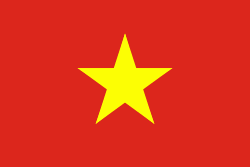Bac Giang province (Tỉnh Bắc Giang)
The province lies in the Red River Delta and is bordered by Quảng Ninh to the east, Lạng Sơn to the north, Thái Nguyên and the urban district of Sóc Sơn in the capital Hanoi to the west, and Bắc Ninh and Hải Dương to the south.
Bắc Giang's history is traced to the Hùng kings of the Hong Bang period, when Vietnam was known as Văn Lang. Bắc Giang was in the division of Võ Ninh.
During the Lê dynasty, the province was the prefecture of Bắc Hà. Following the ascent of the Nguyễn dynasty, it became the prefecture of Thiên Phúc in 1822, before becoming the prefecture of Đa Phúc during the time of Emperor Tự Đức. From 5 November 1889 to 9 September 1891, there existed the province of Lục Nam. It comprised the districts of Bảo Lộc, Phượng Nhỡn, Lục Nam, Hữu Lũng (split from Lạng Giang and Bắc Ninh Province) and the district of Yên Bái (split from Lạng Sơn Province). In 1891 after the return of the districts of Bảo Lộc and Phượng Nhỡn back to Bắc Ninh province, Lục Nam was abolished and integrated into Đạo Quan Binh I.
The modern province of Bắc Giang was founded on 10 October 1895, when it was created out of Bắc Ninh Province. It initially comprised the prefectures of Lạng Giang and Đa Phúc and the districts of Kim Anh, Yên Dũng, Phượng Nhỡn, Việt Yên, Hiệp Hòa, Yên Thế and some small territories south of Lục Nam River. The province capital was Phủ Lạng Thương, which is now the city of Bắc Giang. In 1896, the prefecture of Đa Phúc and the Kim Anh District was returned to Bắc Ninh Province.
In March 1945, Japanese troops conducted multiple massacres of French prisoners of war in Bắc Giang province. Immediately after the surrender of the Bắc Giang garrison, they bayoneted 45 prisoners of war to death; four badly wounded men survived. On 11 March 22 prisoners were killed on the banks of the Cầu River. Thirteen more were killed in a similar fashion two days later. On 14 March, 14 French prisoners were executed behind a church.
In 1950, during the Democratic Republic of Vietnam, Bắc Giang was put into the Confederation of Northern Vietnam (Liên Khu Việt Bắc) by the communist Việt Minh and comprised seven districts: Hiệp Hoà, Lục Ngạn, Yên Thế, Lạng Giang, Việt Yên, Yên Dũng, Hữu Lũng. On 22 February 1955, the Sơn Động District (Quảng Yên province) was incorporated into Bắc Giang Province. On 1 July 1956, upon the formation of the Autonomous Region of Northern Vietnam (Khu Tự Trị Việt Bắc), the Hữu Lũng District was transferred to Lạng Sơn Province. On 21 January 1957, the districts of Sơn Động and Lục Ngạn were divided into the three districts of Sơn Động, Lục Ngạn and Lục Nam. On 27 October 1962, Bắc Giang merged with Bắc Ninh into the new Hà Bắc province, until it was re-partitioned on 1 January 1997 into its previous components.
The province's name was derived from the Sino-Vietnamese 北江, meaning "north of the river".
Map - Bac Giang province (Tỉnh Bắc Giang)
Map
Country - Vietnam
 |
 |
| Flag of Vietnam | |
Vietnam was inhabited by the Paleolithic age, with states established in the first millennium BC on the Red River Delta in modern-day northern Vietnam. The Han dynasty annexed Northern and Central Vietnam under Chinese rule from 111 BC, until the first dynasty emerged in 939. Successive monarchical dynasties absorbed Chinese influences through Confucianism and Buddhism, and expanded southward to the Mekong Delta, conquering Champa. The Nguyễn—the last imperial dynasty—surrendered to France in 1883. Following the August Revolution, the nationalist Viet Minh under the leadership of communist revolutionary Ho Chi Minh proclaimed independence from France in 1945.
Currency / Language
| ISO | Currency | Symbol | Significant figures |
|---|---|---|---|
| VND | Vietnamese đồng | ₫ | 0 |
| ISO | Language |
|---|---|
| KM | Central Khmer language |
| ZH | Chinese language |
| EN | English language |
| FR | French language |
| VI | Vietnamese language |















